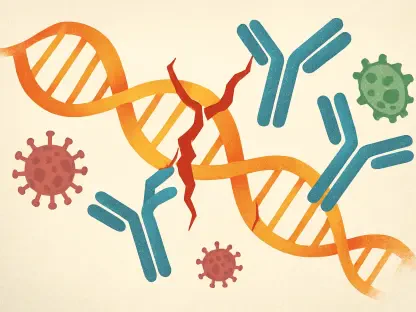In the quest to improve the quality of life for the aging population, a research team from Kyushu University has made a groundbreaking discovery that may pave the way for combating age-related muscle atrophy. As people age, the decline in muscle mass and function becomes a significant concern, especially in super-aging societies like Japan, where the elderly population is steadily increasing. The team’s development of a new antibody that targets the root cause of muscle degeneration marks a crucial step towards enhancing muscle health in the elderly.
The Role of Hepatocyte Growth Factor (HGF) in Muscle Regeneration
Understanding the Importance of HGF
HGF is pivotal in muscle development, regeneration, and repair, primarily through its activation of satellite cells. These cells are a type of stem cell responsible for muscle fiber formation during exercise or when an injury occurs. Professor Ryuichi Tatsumi’s team identified that the protein is integral to maintaining muscle health, underscoring its significance in tackling age-related muscle atrophy.
HGF’s typical role includes activating satellite cells, which then proliferate and differentiate to form new muscle fibers. However, as we age, the efficiency of HGF’s activation of these satellite cells diminishes. The team pinpointed a process called nitration, where nitrogen dioxide attaches to the tyrosine amino acid on HGF, leading to a reduction in its physiological activity. This accumulation over time results in impaired muscle function and regeneration, exacerbating the issues related to muscle atrophy in the elderly.
The Challenge of Nitration
Nitration of HGF is a natural process that negatively impacts its ability to support muscle repair and regeneration. The prevalence of nitration intensifies with age, contributing to the decreased muscle function observed in older individuals. By identifying nitration as a key factor hindering HGF’s effectiveness, the Kyushu University team was able to focus their research on counteracting this biochemical modification. The challenge was to develop a method that could prevent nitration without disrupting HGF’s natural role in muscle regeneration. This intricate balance is crucial for the successful restoration of muscle mass and function in the aging population.
Development of Targeted Antibodies
Discovery and Testing of Antibodies
To tackle the problem of HGF nitration, the researchers aimed to develop antibodies that would specifically bind to the tyrosine sites on HGF, thereby preventing nitration. After extensive testing on rat cell cultures, they identified two promising antibodies: 1H41C10 and 1H42F4N. These antibodies exhibited the capability to block the nitration process effectively. Notably, 1H41C10 was found to block nitration at both tyrosine sites on HGF, while 1H42F4N blocked nitration at just one site.
The identification of these antibodies is a significant step forward, as it demonstrates the feasibility of preventing nitration without impeding HGF’s capacity to activate satellite cells. The successful targeting of specific sites on HGF suggests that these antibodies could be refined and developed into effective treatments for age-related muscle atrophy. The research team’s breakthrough holds promise for creating therapies that not only inhibit muscle degeneration but also promote muscle regeneration.
Implications for Muscle Regeneration
The development of antibodies that prevent HGF nitration without disrupting its original function provides a two-fold benefit for muscle health. By preserving HGF’s ability to activate satellite cells, the antibodies ensure that muscle repair and regeneration processes continue unhindered. This breakthrough offers significant potential for developing targeted therapies tailored to the needs of the aging population, who are most affected by muscle atrophy.
Moreover, the implications of this research extend beyond muscle health. Since HGF plays a role in various tissues and organs, there is potential for these antibodies to have therapeutic applications in other health conditions linked to impaired regeneration. The ability to maintain the physiological activity of HGF could pave the way for innovative treatments in multiple medical fields.
Future Research Directions
Steps Toward Human Application
Although the findings from Kyushu University are promising, further research is needed before these antibodies can be applied in human treatments. The transition from cell culture testing to clinical trials involves rigorous testing to ensure the safety and efficacy of these antibodies in humans. The next steps will include detailed studies to understand the long-term effects and potential side effects of these antibodies in aging individuals.
Professor Tatsumi’s team aims to continue their research, with the hope of eventually developing a marketable therapy for age-related muscle atrophy. Collaborations with other research institutions and pharmaceutical companies may accelerate this process, bringing the benefits of this breakthrough to the aging population in the near future. The team’s work is a testament to the potential of targeted therapies in improving not only muscle health but also overall quality of life for the elderly.
Broader Impact and Potential Applications
In the quest to enhance the quality of life for the aging population, a research team from Kyushu University has made a groundbreaking discovery that could pave the way for combating age-related muscle atrophy. As people grow older, they often face a decline in muscle mass and function, a significant issue in super-aging societies like Japan, where the elderly population is steadily increasing. The team’s development of a new antibody that targets the root cause of muscle degeneration is a crucial step towards improving muscle health in the elderly.
Their innovative approach may not only help in addressing muscle atrophy but also provide a solution to a common problem faced by aging individuals worldwide. This new antibody treatment could potentially restore muscle strength and function, enabling the elderly to maintain independence and a higher quality of life for longer periods. Given the growing number of older adults globally, this research has profound implications, highlighting the importance of scientific advancement in extending healthy living and reducing the burden of age-related health issues on society.









